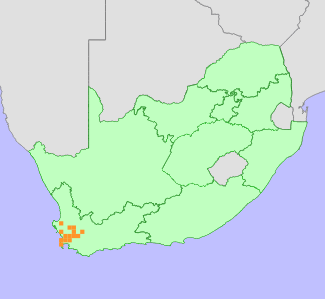|
Scientific Name | Babiana fragrans (Jacq.) Steud. |
Higher Classification | Monocotyledons |
Family | IRIDACEAE |
Synonyms | Babiana disticha Ker Gawl., Babiana plicata Ker Gawl., Babiana stricta (Aiton) Ker Gawl. var. sulphurea in sense of G.J.Lewis (1959), not of (Jacq.) Baker (misapplied name), Gladiolus fragrans Jacq. |
National Status |
Status and Criteria | Near Threatened B1b(iii,v)+2b(iii,v) |
Assessment Date | 2021/02/11 |
Assessor(s) | L. von Staden & D. Raimondo |
Justification | This species has an extent of occurrence (EOO) of 13 428 km², and an area of occupancy (AOO) of 120 km². It is known from between 20 and 30 locations. It was a formerly very common species that has lost a lot of habitat in low-lying areas between Stellenbosch, Paarl and Cape Town and within the Ceres valley. It is experiencing ongoing habitat loss due to urban development, agricultural expansion and alien plant invasion. It almost qualifies to be listed as Vulnerable under criteria B, and is therefore listed as Near Threatened. |
Distribution |
Endemism | South African endemic |
Provincial distribution | Western Cape |
Range | It is endemic to South Africa, occurring in the Western Cape Province from Ceres and Malmesbury to the Cape Peninsula. |
Habitat and Ecology |
Major system | Terrestrial |
Major habitats | Fynbos |
Description | It is found in fynbos and renosterveld, in low-lying sandstone, granite and occasionally clay slopes and flats. |
Threats |
| This formerly extremely common species (known from nearly 100 herbarium collections) has lost significant areas of its habitat in low-lying areas of the Western Cape. The range is about 65% transformed (estimated using landcover data GIS), but a population reduction cannot be inferred as habitat loss occurred over a long period (±200 years) and this species is relatively short-lived (generation length ±10-15 years). It is still quite common, and many subpopulations remain protected within mountain reserves, but there is ongoing loss of habitat in low-lying areas mainly due to urban expansion, agricultural expansion and alien invasive encroachment. |
Population |
This species remains at many locations and subpopulations have high numbers of individuals. The population has declined by more than 60% from its original size, loss is inferred both from historic herbarium collections and from loss of suitable habitat. The population continues to decline as a result of ongoing but slow conversion of habitat for development and crop cultivation as well as ongoing degradation as a result of invasive alien species.
|
Population trend | Decreasing |
Conservation |
| It is conserved in Jonkershoek Forestry Reserve, Groot Winterhoek Wilderness Area, Hawequa Nature Reserve, Quaggasberg Private Nature Reserve, Tygerberg Nature Reserve, Table Mountain National Park. |
Assessment History |
Taxon assessed |
Status and Criteria |
Citation/Red List version | | Babiana fragrans (Jacq.) Steud. | NT B1ab(iii) | Raimondo et al. (2009) | |
Bibliography |
Goldblatt, P. and Manning, J.C. 2007. A revision of the southern African genus Babiana, Iridaceae, Crocoideae. Strelitzia 18:1-97. South African National Biodiversity Institute, Pretoria.
Goldblatt, P. and Manning, J.C. 2020. Iridaceae of southern Africa. Strelitzia 42. South African National Biodiversity Institute, Pretoria.
Raimondo, D., von Staden, L., Foden, W., Victor, J.E., Helme, N.A., Turner, R.C., Kamundi, D.A. and Manyama, P.A. 2009. Red List of South African Plants. Strelitzia 25. South African National Biodiversity Institute, Pretoria.
|
Citation |
| von Staden, L. & Raimondo, D. 2021. Babiana fragrans (Jacq.) Steud. National Assessment: Red List of South African Plants version 2024.1. Accessed on 2025/10/29 |
 Comment on this assessment
Comment on this assessment


